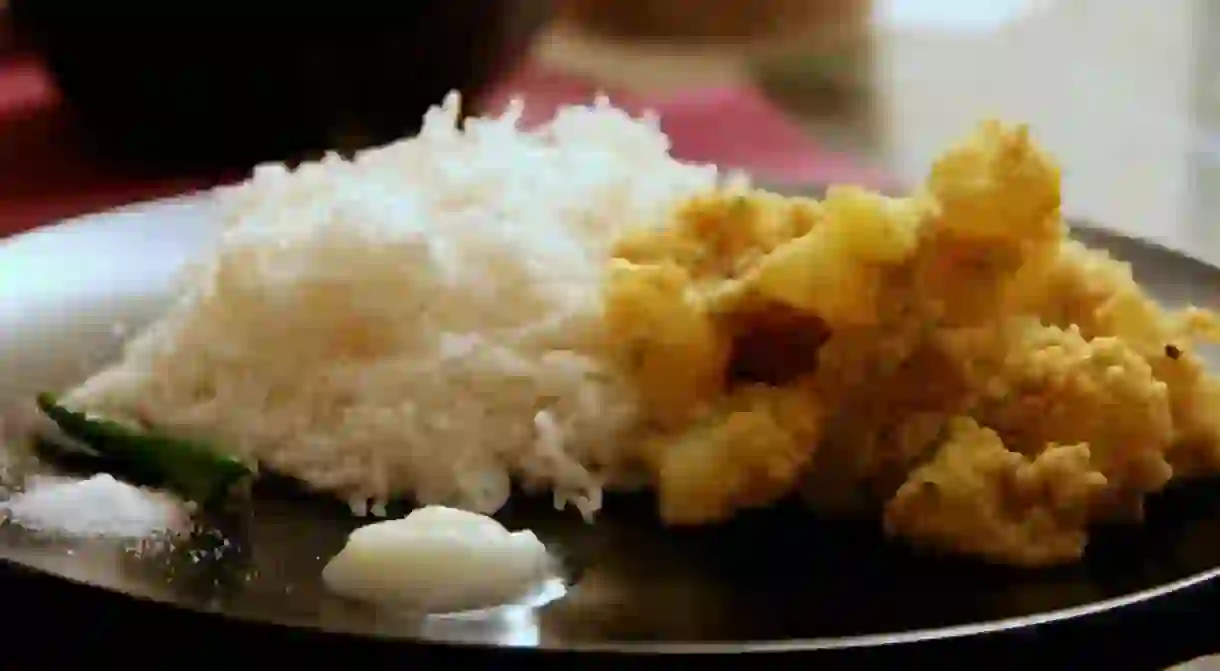14 Bengali Dishes You Have To Try In India

India is a land of diversity – including when it comes Bengali cuisine. We’ve rounded up the best Bengali dishes that you must try while you’re in the area.
Chingri Maachh’er Malaikari or Prawn Malaikari
An eternal Bengali classic, this dish dispels a popular belief that coconut/coconut milk is included only in South Indian dishes. As are almost all Bengali dishes, this, too, is an elaborate cooking affair.
http://instagram.com/p/49MyeVHv2O/
Bhapa Ilish
Basically hilsa fish steamed in mustard paste, bhapa ilish is a hot favorite with rice. The tangy taste and smell of the mustard with the royal fish make a meal a very happy meal.
http://instagram.com/p/BFF_a-gsnGV/
Muri Ghonto
Muri ghonto is a sort of fish pulao made with the fish head of Rohu or Katla and rice and potatoes.
http://instagram.com/p/BEeAGssguz1/
Shukto
Bengalis love their gourds, especially bitter gourd. This is a special dish, and meals are started with it. The idea is to begin with the bitter and end with the sweet. One special thing about this recipe is that while it is a part of your regular home meal, it is also a part of wedding meals.

Narkol Diye Mochar Ghonto
Mocha is basically the banana flower. The banana plant is important among Bengalis. The fruit is eaten – ripe and in raw form; the flowers are made into a sabzi, and the stem is also eaten steamed. The leaves are used to wrap food – in which to cook. This dish is made primarily with the florets of the banana flower and desiccated coconut.
http://instagram.com/p/BEsk0thpUB1/
Aalu Posto
A Bengali’s comfort food, aalu posto comes in many variations with vegetables; however, the traditional recipe is a potato dish with poppy seeds.

Bhaja
Bhaja is a pre-requisite for any Bengali meal, be it for festivities or your regular home meal. Bhaja means fry, and this could be any vegetable that has been fried crisp. Potatoes, brinjal, pointed gourd, lady finger, and pumpkin are the usual favorites.
http://instagram.com/p/BDpKSVrPmpa/
Mishti Polao
This is a savory rice dish, though sweet. The inclusion of the sweetness varies and can be extreme, depending on family tastes. The mishti polao is usually eaten with mutton or fish curry.
http://instagram.com/p/821UfLBNGK/
Maachh’er Maatha Diye Moog Dal
Moong dal made with fish head is a favorite among Bengalis and is a must on the menu for any occasion. Usually made with the head of Rohu fish, this takes a humble dal chawal up by multiple notches.
http://instagram.com/p/8-cfn6SrvF/
Narkol diye Chhola’r Dal
If a non-vegetarian dal dish had you confused, here is one for the pure vegetarians. Bengal gram made with coconut is a pure vegetarian delicacy and is usually a part of all celebratory menus. While it is eaten with rice or chapati, it goes best with luchi (puri made of maida).
Korishutir Kochudi (Kachodi with peas as filling)
Come winter, and the Bengali households start chirping with preparations for these pea kachodis. Eaten during breakfast, for meals or with tea, these kachodis are a little different from your usual kachodis. They are bigger in size and eaten like stuffed puris – with dum aalu or any other variation of aalu sabzi.
Teen Kona Neemki
Triangle in shape, this flaky tea time accompaniment is a deep-fried savory recipe which you needn’t have only at tea time. Have it for breakfast or have it as a daytime snack – you cannot stop at just one.
Lady Kenny
A favorite of Lady Charlotte Canning who was the wife of Lord Charles Canning, this sweet has been named after her. Also known as Langcha, this is a deep-friend chhena sweet with raisins in the center.
Lobongo Lotika
Bengalis have a sweet for every occasion, and that is no secret. Lobongo Lotika is one such treat and gets its name from the fact that the pastry is folded and sealed with the help of a clove; lobongo means clove. Made with maida, cardamom, raisins, grated coconut, khoya, ghee, nuts, nutmeg powder and, of course, cloves, the mixture is blended with powdered sugar. This is then added to the center of pastry dough and shaped and deep fried.
http://instagram.com/p/qa0SMrBFmf/













